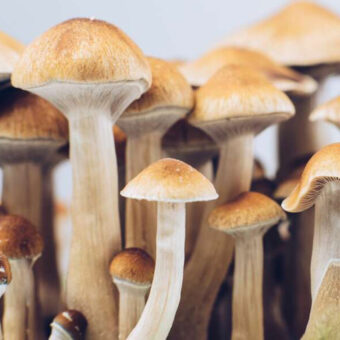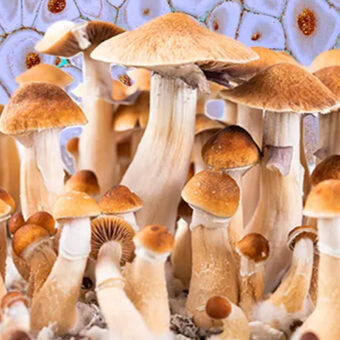
The word “shrooms” is a colloquial term for magic mushrooms, which are fungi containing psychoactive compounds like psilocybin and psilocin. Over the decades, “shrooms” has not only become a term of endearment in popular culture but also a gateway to discussions about science, spirituality, mental health, and nature’s mysteries.
Origins of the Term
The nickname “shrooms” emerged as a shortened, playful version of the word “mushrooms,” gaining widespread use during the counterculture movements of the 1960s and 1970s. This era, marked by a collective yearning for exploration and self-discovery, saw the rise of psychedelics as a cultural phenomenon. Magic mushrooms, containing the psychoactive compounds psilocybin and psilocin, became synonymous with expanded consciousness, spiritual awakening, and breaking away from conventional societal norms. As such, the term “shrooms” encapsulated not only the substance but also the casual, adventurous spirit of the times.
During this period, magic mushrooms became a staple in the toolkit of the psychedelic revolution, alongside LSD and mescaline. Advocates like Timothy Leary and other figures of the era promoted the use of psychedelics as tools for inner exploration, creative breakthroughs, and spiritual transcendence. In this cultural context, the easy, relaxed nature of the word “shrooms” reflected its association with experimentation, self-expression, and a laid-back ethos. Unlike the more formal scientific terminology or traditional names tied to indigenous practices, “shrooms” fit into the lexicon of a youth movement embracing freedom, simplicity, and rebellion against rigid societal structures.
However, the history of magic mushrooms and their cultural significance stretches far deeper than their adoption in 20th-century counterculture. Indigenous communities around the world have been using psilocybin mushrooms for centuries, if not millennia, in sacred ceremonies. For instance, the Mazatec people of Mexico, whose traditions date back thousands of years, referred to psilocybin mushrooms as niños santos or “holy children” and incorporated them into spiritual practices to connect with the divine and seek guidance. These rituals imbued magic mushrooms with profound reverence, far removed from the casual nickname “shrooms.”
Interestingly, the shift to slang terms like “shrooms” mirrors the broader Western tendency to simplify and reframe complex cultural elements to fit a more accessible narrative. While modern usage often reflects recreational or experimental contexts, the roots of psilocybin mushrooms in ancient traditions highlight their deeper spiritual and medicinal significance. This juxtaposition makes the nickname “shrooms” both a product of its time and a reflection of the enduring mystery surrounding these fungi.
Today, “shrooms” remains a popular term, carried forward not just by nostalgia for the counterculture era but also by a growing interest in psychedelic-assisted therapy and wellness. With the resurgence of research into the therapeutic benefits of psilocybin for mental health issues like depression, PTSD, and anxiety, magic mushrooms are transitioning from counterculture symbols to mainstream tools for healing. Even as the term “shrooms” continues to evoke images of youthful rebellion and carefree experimentation, its broader cultural relevance underscores a deeper connection to humanity’s timeless quest for understanding the mind, spirit, and the natural world.
Ancient Roots
Magic mushrooms have been used by indigenous cultures for centuries. The Aztecs referred to psilocybin mushrooms as teonanácatl, or “flesh of the gods,” and incorporated them into spiritual rituals to connect with divine realms. The simplicity of “shrooms” as a term is a modern contrast to these deeply spiritual origins, yet it reflects the timeless curiosity surrounding these fungi.

Shrooms in Modern Culture
Today, the word “shrooms” is often associated with personal transformation, healing, and creativity. Movies, music, and literature often reference shrooms as a means to explore altered states of consciousness. In recent years, their reputation has shifted from purely recreational to therapeutic, as studies reveal their potential to treat depression, anxiety, PTSD, and more.
Moreover, the casual vibe of “shrooms” has helped normalize conversations around psychedelics. The term is often featured in wellness blogs, social media discussions, and even emerging branding efforts as magic mushrooms gain legal acceptance in places like Oregon and Colorado.
The Science Behind Shrooms
Shrooms achieve their effects through psilocybin, which interacts with serotonin receptors in the brain, leading to visual distortions, euphoria, and profound emotional experiences. Users often report a sense of unity, introspection, and spiritual awakening. The word “shrooms” encapsulates this transformative potential in a simple, accessible way, making a complex topic approachable.
Cultural Associations with the Word
- Playfulness: The term “shrooms” evokes an air of whimsy, much like the mushroom’s fairy-tale-like appearance.
- Mystery: As a slang term, “shrooms” hints at the enigmatic qualities of psychedelic experiences.
- Community: Among enthusiasts, the term fosters a sense of shared language and understanding.
Shrooms and Society’s Future
As society continues to embrace the benefits of psychedelics, “shrooms” may evolve from a counterculture term to a mainstream one. With more states and countries decriminalizing or legalizing psilocybin, the journey of “shrooms” is far from over.
Whether you’re a curious beginner or an experienced psychonaut, the term “shrooms” carries an essence of discovery, reminding us of the interplay between nature, science, and the human mind.
Disclaimer: This article is for informational purposes only and does not endorse the use of illegal substances.

Ready for Blast Off?
Shop California Shrooms Today!
-
 Thai Tanic Mushrooms$40.00
Thai Tanic Mushrooms$40.00 -
 Jedi Mind Fuck Mushrooms$40.00
Jedi Mind Fuck Mushrooms$40.00 -
 B+ Mushrooms$40.00
B+ Mushrooms$40.00 -
 Blue Meanie Mushrooms$40.00
Blue Meanie Mushrooms$40.00 -
 Golden Teacher Mushrooms$40.00
Golden Teacher Mushrooms$40.00



